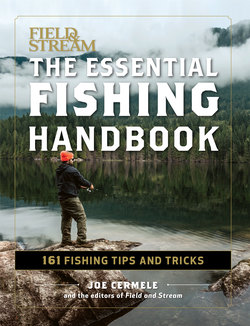Читать книгу The Essential Fishing Handbook - Joe Cermele - Страница 28
На сайте Литреса книга снята с продажи.
Оглавление9
Have a Cane-Do
Attitude
10
Know Your
bluegill
You could use one of those fancy side-scan sonar depthfinderswith the new underwater fish-eye orthographic readouts. Or you could go cut a switch of bamboo and do a lile cane-pole fishing. If you choose the laer, a decent cane pole is as close as the nearest stand of bamboo. Ordinary backyard bamboo works just fine for panfish, bass, and small catfish. Make a cane pole our way, with the line anchored to the pole along its entire length, and you’ll be able to land anything that doesn’t pull you into the pond first.
STEP 1 Start by cuing yourself a straight piece of cane about feet ( m) long. Next, trim the leaf stems as close as possible. Saw through the fat end at the boom of a joint
so the bu end will have a closed cap. Finally, smooth the rough edgeswith sandpaper.
STEP 2 Tie a string to the slender tip. Suspend the cane as it dries to tan color (could take several weeks). Straighten a curved pole by weighting it with a brick.
STEP 3 Using an arbor knot, aach -pound ( kg) line a few inches above where you hold the rod. Lay the line along the length of the pole and whip-finish the running line to the rod with old fly line at two spots—a few feet apart—in the middle of the rod and at the tip. (You do this so if the rodtip breaks, the line will remain aached to the pole.) Aach a -foot (6 cm) monofilament leader. Total length of line from tip of rod should be to 6 feet ( to m). Finish with a slip bobber, split shot, and a long-shank hook.
Most anglers cut their teeth as kids chasing these easy-to-catch scrappers at the neighborhood pond or creek. Bluegills will eat anything from a fresh, lively cricket to a ball of stale white bread on a hook. Don’t want to use bait? Any little fly, small spinner, soft-plastic grub jig, or tiny crankbait will do. But these aggressive fish aren’t all child’s play; serious grown-up anglers invest a lot of time hunting the biggest of the big in lakes and reservoirs across the country, as bluegills can break 2 pounds and are excellent on the table. The current world-record bluegill weighed in at an amazing 4 pounds, 2 ounces (2 kg). If it’s jumbo fish you’re after, search around weedbeds, humps, and brush piles in 5 to 0 feet (.5 to 3 m) of water. If you just want to catch a whole mess and don’t care about size, find the local public dock, cast a worm under a bobber, and start having fun.
